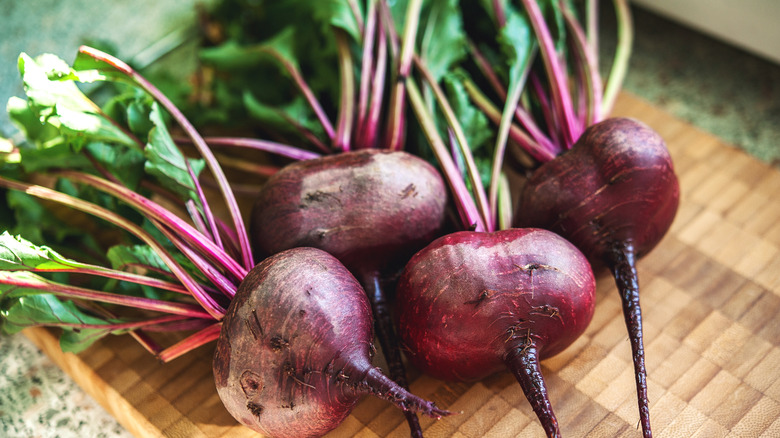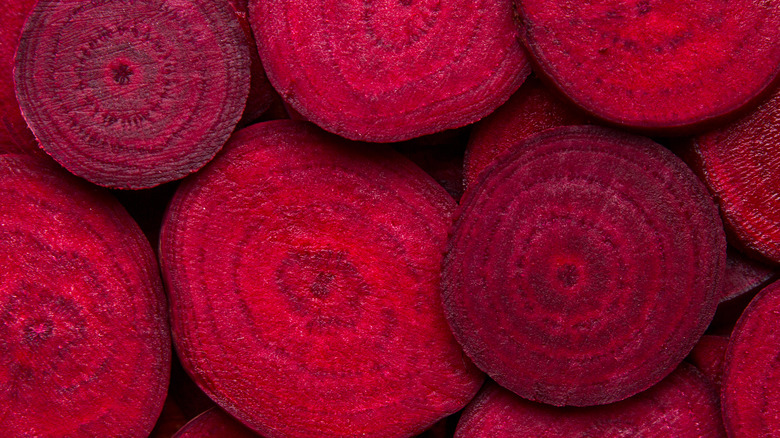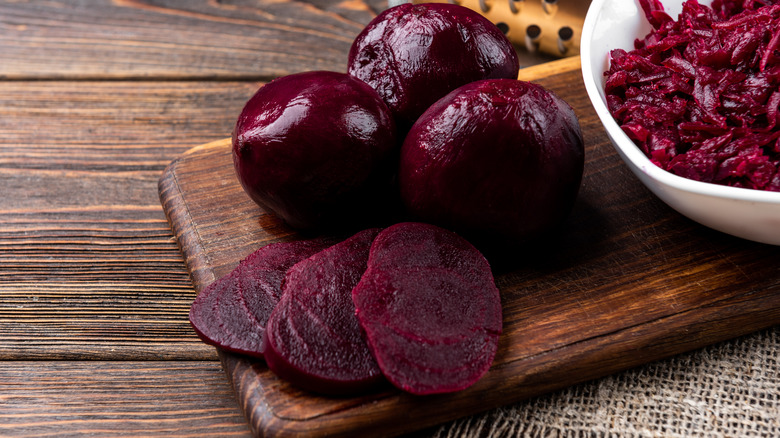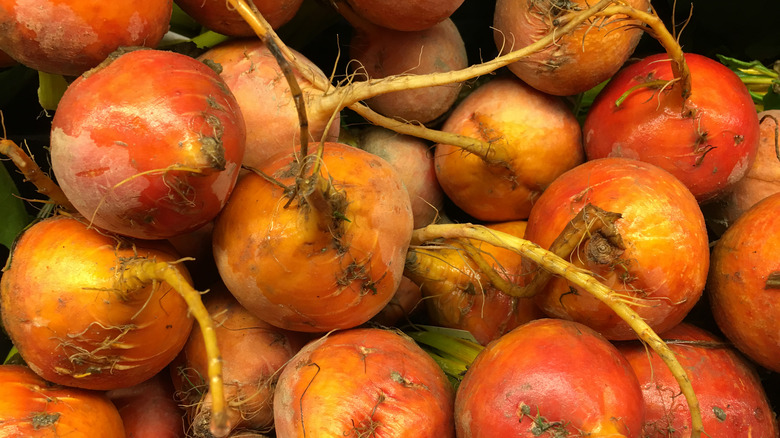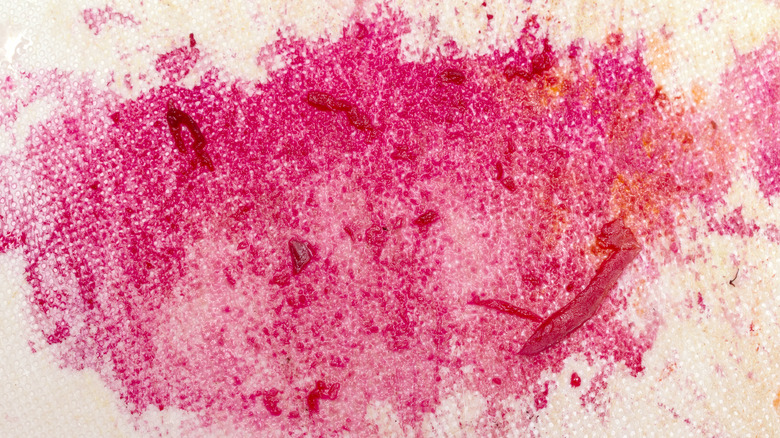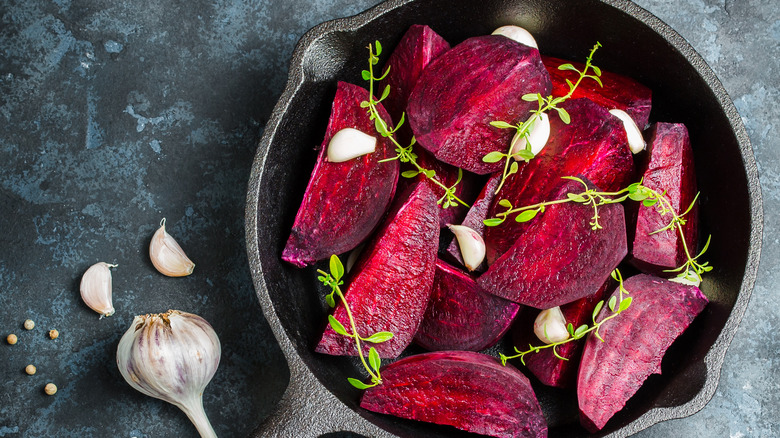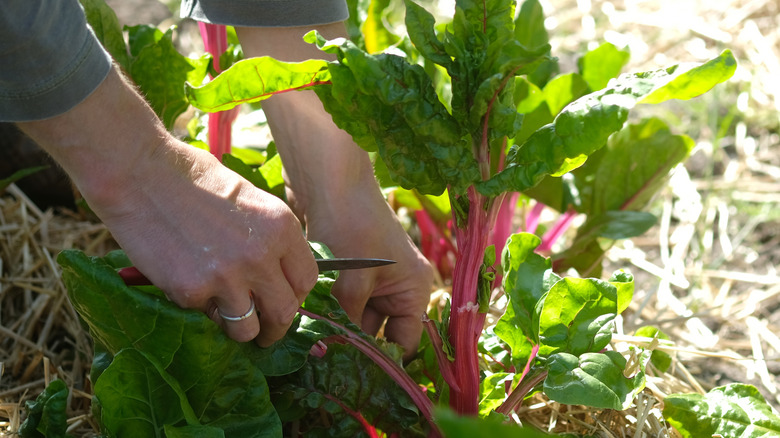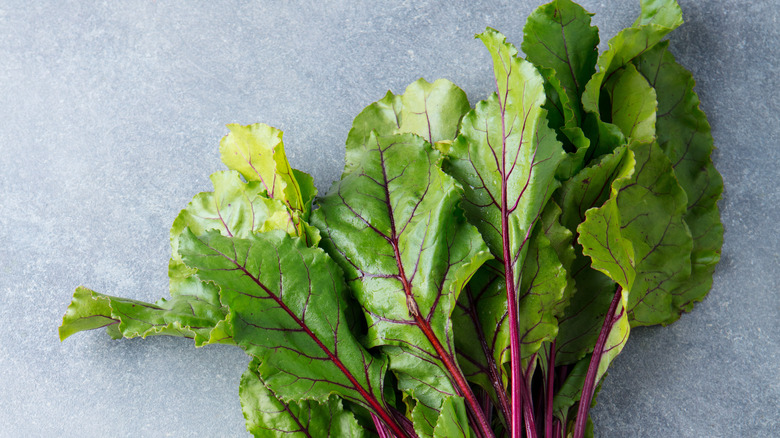Everything You Need To Know About Beets
Whether you're the kind of person who grabs beets every time you visit your local farmer's market, or the type that winces at the thought of even seeing them atop your dinner salad, both are pretty common reactions. In fact, most people have a very strong "love 'em or hate 'em" opinion of the vegetable. If you fall into the beet-hater camp, you aren't alone: Even former first lady Michelle Obama once told Food & Wine (via Refinery 29) that beets were one of few vegetables she couldn't stand. In fact, she and 44 reportedly banned them from the White House garden.
On the other hand, if you happen to like the infamous root veggie, know that you've got plenty of folks on your side, too. Beets have been incredibly popular for centuries and remain a staple ingredient in regional diets and cuisines all over the world. They're even the foundation for borscht, a well-loved stew popular in eastern European countries. But what exactly is a beet, and how do they taste?
Beets (beta vulgaris) are a type of vegetable with literal long roots that go back as far as the days of ancient Babylon (via PBS). Like Swiss chard, they have a vibrant, leafy top with a reddish colored stem, and — like a parsnip — they have a bulbous taproot that grows entirely underground. Historically, the bulbs were used by the Romans for medicinal purposes, while the greens were eaten like salad. People didn't get the idea to eat the roots until the 1500s, and even then, using them for cooking didn't become popular until several hundred years later. Though it's unclear who is responsible for making beetroots cool, it's widely believed that it's owed to the Italians, which makes sense because beets fit well in the Mediterranean diet.
Today, beets are cultivated all around the world, including parts of Asia, Europe, and North America. And although once upon a time many people in the US thought of them exclusively as a boring side dish, in recent years, beets have triumphantly resurged in popularity for home cooks and professional chefs. With their eye-catching, jewel-toned hue and distinct, earthy flavor, beets make for a colorful addition to any meal. And best of all, they're super good for you.
What do beets taste like?
If you're a fan of beets, you're probably used to having to defend your affinity for the taproot to the haters. As NPR notes, it's common for people who dislike beets to justify their disdain with accusations that the veggie tastes like straight-up dirt, or even dirty socks, neither of which sounds particularly appetizing.
All passionate debates aside, it's worth exploring where beets get their notable, earthy flavor. (And just so we're clear, the earthiness isn't because you're eating actual dirt.) According to the Journal of Agricultural and Food Chemistry, beets get their signature earthy flavor from an organic compound called geosmin, which is also found in mushrooms and spinach (via Science Direct). Apparently, human taste buds are super sensitive to geosmin, which may be why most people either really love beets or really hate them, with few in betweens. The taste is strong for pretty much everyone, not unlike cilantro.
Of course, that flavor profile can change depending on how you eat beets. Fresh out the ground, beets are extra chewy and bitter. But after cooking, they can develop a pleasantly soft, silky texture and become much sweeter.
Are beets good for you?
There are plenty of good reasons to start eating beets, but one of the most important is you'll be treating your body to a buffet of possible health benefits. As Healthline notes, beets (or beetroots as they're also referred to) contain a good number of vitamins and minerals like iron, manganese, and vitamin C that have been seen to reduce blood pressure, support liver function, and possibly help maintain potassium and folate levels.
At the same time, increasing your intake of beets may result in some side effects, too — like turning your urine or stools blood-red in color. While it may be alarming, it's no cause for concern. The pigmentation solely comes from the natural dyes in the root and there's nothing internally wrong when you see this. In fact, the occurrence is so common there's even a name for it: beeturia. (It sounds way worse than it actually is.) Another potential side effect of eating too many beets can be an increased risk of kidney stones due to the high number of oxalates in the plant, but this is generally only an issue for people that are already at a higher risk for kidney-related conditions.
Yet, for the most part, beets are a vegetable that can be safely consumed — even daily. Of course, if you're not used to them, you may want to proceed with caution. As Healthline points out in another article, eating too much fiber (and beets have plenty) at once can result in an upset stomach, bloating, and constipation. To avoid this, try adding a small serving of beets slowly to your diet to see how your body responds and build up from there.
How to properly select and store beets
While you can find pre-sliced, pre-cooked beets in the refrigerated or canned food sections of many grocery stores (which, by the way, Gordon Ramsay is all for using, as seen on YouTube, so no judgment there), you may want to pick up fresh varieties so you can prepare them how you like at home.
Since beets are grown all around the world, they're pretty accessible year-round. You can generally find raw beets in the produce department. They resemble larger radishes with round roots and a long stem. Depending on the variety of beet, they'll have a reddish-brown, or even a purple, yellow, or orange bulb with a stringy root at the bottom, and long colorful stems and leafy greens that look Swiss chard. (Unlike chard, though, the beet has a round taproot).
Generally, beats will have a coating of dirt on them, which isn't anything to worry about since the taproot is primarily grown underground, so it's to be expected. When selecting beets at the store, The Food Network says to feel for bunches that have firm bulbs (but are never squishy), and choose ones that are relatively the same size as each other. That's because a grouping with various sized roots means they won't cook at the same rate. Be wary of any spots or bruising, or leaves that look overly wilted as that can mean the beets are not at their prime.
To store for later, first trim the leaves down to two inches from the taproot. (The Spruce Eats notes that leaving the leaves fully attached allows the greens to suck up all the moisture.) Then, wipe off any excess dirt and moisture with a paper towel and wrap the root loosely in a plastic bag. Do not scrub until you're ready to use them. Meanwhile, stash the greens in a totally separate bag and keep in the refrigerator for up to two weeks (via Eating Well).
There are many beet varieties to choose from
When you visit the supermarket, co-op, or better yet, a farmer's market, you'll find beets in a wide variety of colors and sizes.
In addition to the popular red beets, there are also golden beets, which look practically identical to table beets except for their yellow-colored root. This type is known for having a milder flavor than the red ones, which makes them a great option for people that want to warm themselves up to beets for the first time — or for anyone that finds the earthy flavor in red beets too intense.
Then there are Chioggia beets, which are described as the Italian "heirloom" variety, per Parade. They look like a regular beet on the outside, but cut into them and you'll find striped, bullseye-patterned magenta rings covering the flesh. This type can be used interchangeably with standard red and golden beets depending on the recipe. Just as a note, though — when they're cooked, Chioggia beets lose that pretty pattern, so if you're going for a particular aesthetic for your dish, you may want to keep them raw.
Other less common varieties include the cylindra beet, which Beetroot.org notes can be a substitute for a carrot due to its long shape, as well as the ivory-colored avalanche beets (via All American Selections) than are reportedly even milder in flavor than the golden ones.
The other famous variety is the sugar beet, which looks more like a parsnip and is grown almost exclusively for sugar production (via USDA). Ironically, despite their name, this variety of beet is less sweet than the ruby red table beets. Food blogger Modern Farmer describes them as tasting a bit like a potato. For this reason, it's uncommon to see them in grocery stores.
Dealing with stubborn beet stains
It's no secret that beets — whether raw or cooked — can be quite messy. Like a pomegranate, your kitchen can look like a literal bloodbath after you hack into them. To keep your cabinets and countertops from looking like a scene in a Quentin Tarantino movie, Bon Appétit recommends handling beets only while wearing gloves and slicing the veggie over plastic cutting boards only, since those can be bleached after use to remove any stains. (And if you were wondering, no, you should not bleach your wooden cutting board).
Should you get the red beet stain all over your hands, no need to fret. The Spruce Eats shares a tip that you can remove the dye from your fingers by simply scrubbing them with a lemon-salt solution (just make sure you have no open cuts first because, ouch!), and then follow up with a normal wash and you'll be good as new.
How to cook beets and add them to dishes
One thing all beet lovers probably know to be true is that the key to making sure they taste good is drawing out their natural sweetness. This is best achieved through cooking methods like roasting. Since beets are packed with plenty of natural sugars, they caramelize really easily and develop a super yummy, soft texture when cooked in the oven. Eating Well shares that roasted beets makes them taste extra sweet, which might make them more palatable to those that aren't instantly drawn to them.
To prepare your own roasted beetroot, you'll want to cook them in a similar way to a baked potato. After trimming the stems down to less than 2 inches (you'll want to keep a small part attached to prevent bleeding), scrub the bulbs with a vegetable brush, then wrap them in an aluminum foil cocoon to protect your cookie sheets. Bake in a 400-degree Fahrenheit oven until fork tender (approximately 40 minutes to one hour), and you'll have perfectly roasted beets ready for indulging.
If oven-roasting is not your thing, not to worry. Other beet fans swear by the power of the right pairing. Bon Appétit suggests serving cooked beets with something bright and acidic, like vinegar or citrus, to provide a nice contrast and balance out the veggie's muddy, earthy flavor. And even if salads aren't your thing, there are many other ways to enjoy this root vegetable. Beets can be pickled, roasted, steamed, grilled, pureed, juiced, or even baked like a potato chip. You can even use them as natural food coloring for desserts and other dishes.
Growing your own beets is easy to do
Though beets are generally affordable and widely available, nothing beets the satisfaction of growing them on your own. And the best part is cultivating a small beet plant may not be as difficult as you might think.
The Gardening Channel says you can plant table beet seeds in their own container with soil just before the last frost. (This varies from location to location so be sure to consult an almanac for reference.) Once planted, they should grow in about six to eight weeks, provided you keep them in direct sunlight and give them water every week. You'll know when beets are ready to harvest when the leaves are about 4 to 6 inches tall, or if the taproots have started to stick out from the dirt. If you let them grow for too long beyond this stage, they'll develop an unpleasant bitterness.
To remove the roots from the ground, simply loosen the soil around the leaves and carefully remove from the container. Be wary of straight up yanking the beet from the pot to avoid bruising or potentially ripping the leaves and skin. Once out of the container, you can then follow the same cleaning and storage instructions as you would when dealing with fresh supermarket beets. And voila! You'll have organic beets right in your own home.
What you can do with beet greens
Given their signature ruby stems, it can be easy to confuse beetroot leaves with the leaves of rhubarb, which is actually poisonous. But you needn't worry about whether beets' greens come with a warning, since they're perfectly safe to eat. In fact, according to Epicurious, a single serving of beet leaves contains as many antioxidants as a serving of popular superfoods like kale. They're also a superb source of potassium, vitamin K and especially vitamin A — one cup contains 220% of your daily required value of vitamin A, which may support immune system function and vision.
Beet leaves are perfectly fine to cook too. After separating the stems from the root, bathe them in several bowls of cold water to remove any debris, then chop off the leaves and braise over the stove with a bit of olive oil and shallots. Or, if you're looking for a slightly less bitter take on kale chips, try pan roasting them with sea salt.
The bottom line is don't sleep on the greens. After all, if you're going to go to all the trouble to prepare beetroots, you might as well go for eating a double dose of nutrients this special plant provides.
